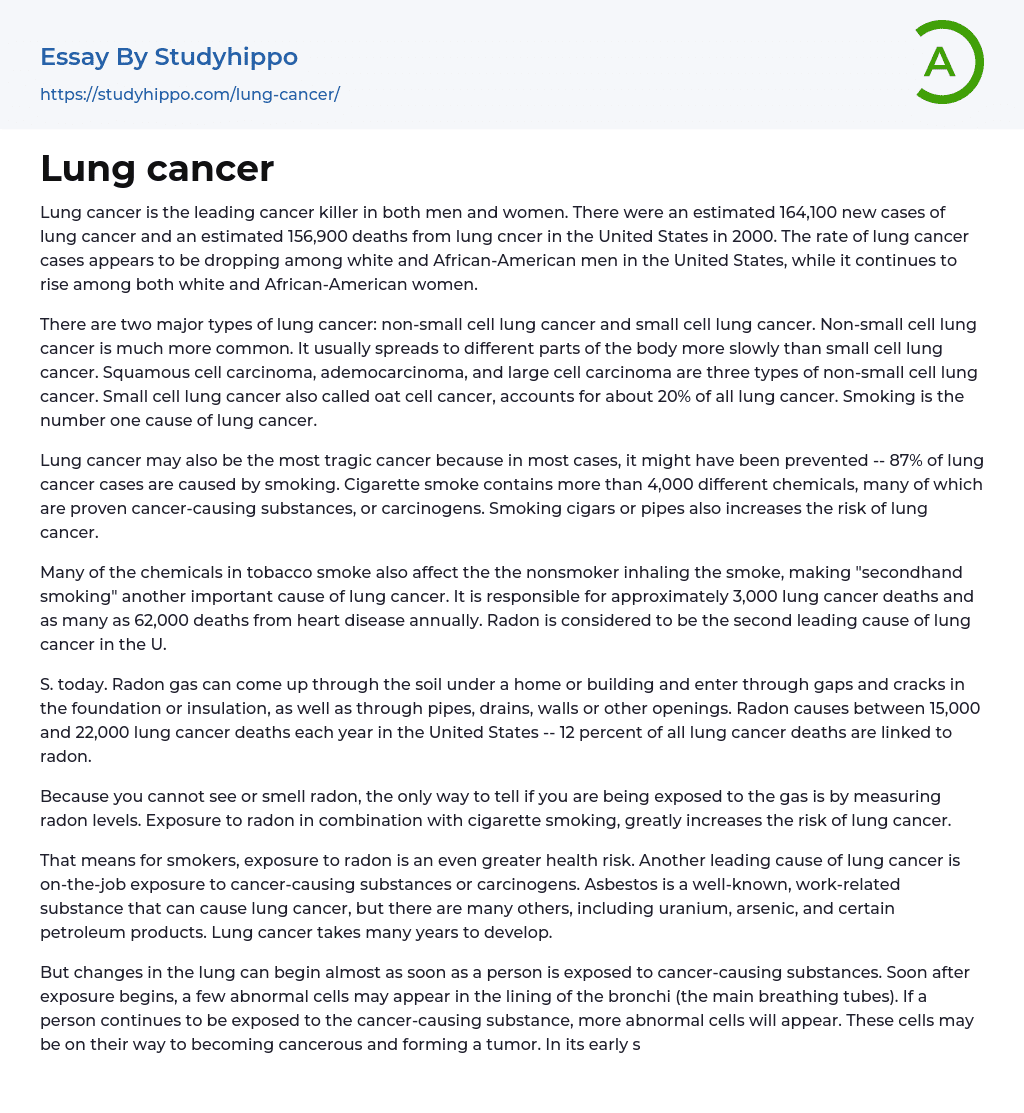Lung cancer is the leading cancer killer in both men and women. There were an estimated 164,100 new cases of lung cancer and an estimated 156,900 deaths from lung cncer in the United States in 2000. The rate of lung cancer cases appears to be dropping among white and African-American men in the United States, while it continues to rise among both white and African-American women.
There are two major types of lung cancer: non-small cell lung cancer and small cell lung cancer. Non-small cell lung cancer is much more common. It usually spreads to different parts of the body more slowly than small cell lung cancer. Squamous cell carcinoma, ademocarcinoma, and large cell carcinoma are three types of non-small cell lung cancer. Small cell lung cancer also called oat cell cancer, accounts for about 20% of
...all lung cancer. Smoking is the number one cause of lung cancer.
Lung cancer may also be the most tragic cancer because in most cases, it might have been prevented -- 87% of lung cancer cases are caused by smoking. Cigarette smoke contains more than 4,000 different chemicals, many of which are proven cancer-causing substances, or carcinogens. Smoking cigars or pipes also increases the risk of lung cancer.
Many of the chemicals in tobacco smoke also affect the the nonsmoker inhaling the smoke, making "secondhand smoking" another important cause of lung cancer. It is responsible for approximately 3,000 lung cancer deaths and as many as 62,000 deaths from heart disease annually. Radon is considered to be the second leading cause of lung cancer in the U.
S. today. Radon gas can come up through the soi
under a home or building and enter through gaps and cracks in the foundation or insulation, as well as through pipes, drains, walls or other openings. Radon causes between 15,000 and 22,000 lung cancer deaths each year in the United States -- 12 percent of all lung cancer deaths are linked to radon.
Because you cannot see or smell radon, the only way to tell if you are being exposed to the gas is by measuring radon levels. Exposure to radon in combination with cigarette smoking, greatly increases the risk of lung cancer.
That means for smokers, exposure to radon is an even greater health risk. Another leading cause of lung cancer is on-the-job exposure to cancer-causing substances or carcinogens. Asbestos is a well-known, work-related substance that can cause lung cancer, but there are many others, including uranium, arsenic, and certain petroleum products. Lung cancer takes many years to develop.
But changes in the lung can begin almost as soon as a person is exposed to cancer-causing substances. Soon after exposure begins, a few abnormal cells may appear in the lining of the bronchi (the main breathing tubes). If a person continues to be exposed to the cancer-causing substance, more abnormal cells will appear. These cells may be on their way to becoming cancerous and forming a tumor. In its early stages, lung cancer usually does not cause symptoms.
When symptoms occur, the cancer is often advanced.
Symptoms of lung cancer include: Chronic cough Hoarseness Coughing up blood Weight loss & loss of appetite Shortness of breath Fever without a known reason Wheezing Repeated bouts of bronchitis or pneumonia Chest pain The doctor
will decide which treatment you will receive based on factors such as the type of lung cancer, the size, location and extent of the tumor (whether or not it has spread), and your general health. There are many treatments, which may be used alone or in combination. These include: SURGERY may cure lung cancer. It is used in limited stages of the disease.
The type of surgery depends on where the tumor is located in the lung.
Some tumors cannot be removed because of their size or location. RADIATION THERAPY is a form of high energy X-ray that kills cancer cells. It is used: In combination with chemotherapy and sometimes with surgery. To offer relief from pain or blockage of the airways. CHEMOTHERAPY is the use of drugs that are effective against cancer cells. Chemotherapy may be injected directly into a vein or given through a catheter, which is a thin tube that is placed into a large vein and kept there until it is no longer needed.
Some chemotherapy drugs are taken by pill. Chemotherapy may be used: In conjunction with surgery. In more advanced stages of the disease to relieve symptoms. In all stages of small cell cancer.
- Addiction essays
- Anatomy and Physiology essays
- Biodegradation essays
- Cancer essays
- Dental Care essays
- Disability essays
- Disease essays
- Disorders essays
- Health Care essays
- Infectious Disease essays
- Inquiry essays
- Intelligence Quotient essays
- Lung Cancer essays
- Medicine essays
- Neurology essays
- Nutrition essays
- Olfaction essays
- Physical Exercise essays
- Public Health essays
- Sex essays
- Women's Health essays
- World health organization essays
- Birth Control essays
- Drug Addiction essays
- Eating Disorders essays
- Epidemiology essays
- Hiv essays
- Hygiene essays
- Obesity essays
- Social Care essays
- Teenage Pregnancy essays




